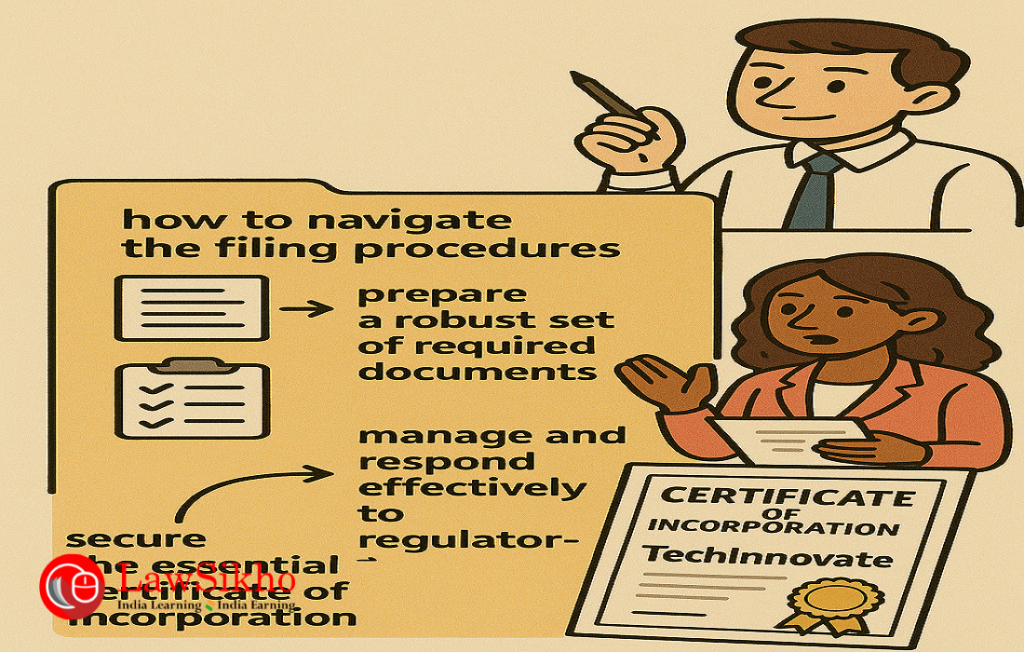Learn how to do the regulatory filings required for a private-to-public company conversion. This third article guides you through form submissions, document preparation, and effective strategies for handling regulatory queries with practical templates and case examples.
Table of Contents
Introduction
In the last two articles, I explained the conversion process using TechInnovate as a company that decided to go public.
I began by assessing whether TechInnovate was ready for the conversion. In the first article (Navigating the legal essentials of company conversion: Private to Public), I reviewed the company’s shareholder structure, board composition, and strategic reasons for converting.
Building upon that foundation, I navigated the intricate process of amending TechInnovate’s foundational documents, such as the MOA and AOA, in the second article (From Private to Public Paperwork: Mastering the Essential MOA & AOA Modifications).
I also secured essential internal approvals for TechInnovate, first from the board of directors, then from the shareholders through an Extraordinary General Meeting (EGM).
But here is something you should know. Internal approvals alone are not enough.
Even a successful shareholder vote at the EGM does not automatically finalise the conversion.
In practice, all the carefully drafted resolutions and amended documents mean little until they receive official regulatory approval from the Registrar of Companies (RoC).
So, my goal in this article is to guide you:
- how to navigate the filing procedures,
- prepare a robust set of required documents,
- manage and respond effectively to regulatory queries, and,
- secure the essential Certificate of Incorporation reflecting TechInnovate’s new public status.
By the end of this article, you will have a clear, practical understanding of how to use documents created in the second article to convert TechInnovate into a public company, smoothly and efficiently.
By the way, this guide focuses on unlisted companies like TechInnovate that are converting from private to public status. It is important to note that requirements may differ based on company characteristics and regulatory oversight.
For instance, companies under sectoral regulators (e.g., RBI for NBFCs, SEBI for listed entities) may face additional requirements, such as SEBI’s LODR compliance or RBI approvals. If your client’s company operates in a regulated sector, you should check the relevant sectoral regulations, as well as the Companies Act.
To begin with, let us look at the regulatory framework that relates to the filing of documents with the RoC.
Navigating the regulatory framework
The regulatory framework for private-to-public conversion revolves primarily around the Companies Act, 2013, and the rules framed thereunder, as you may already know it.
While I examined the substantive provisions in previous articles, for now, all we need to focus on are the procedural aspects – specifically, the forms and filings that formalise the conversion.
For TechInnovate, and indeed for any company undergoing this transformation, the key forms that come into play are:
- Form MGT-14: This form is used to file special resolutions and certain ordinary resolutions with the Registrar of Companies (ROC) under section 117 of the Companies Act, 2013. Since conversion requires passing of special resolutions by the shareholders in an EGM for amendment of the MOA and AOA, this form is essential.
- Form INC-27: This is the primary conversion application form filed under section 14 of the Companies Act, 2013, and Rule 33 of the Companies (Incorporation) Rules, 2014. This form officially requests the conversion from private to public status.
It is worth noting that Forms INC-33 (e-MOA) and INC-34 (e-AOA) are sometimes mentioned in relation to company documentation. However, these forms are primarily designed for new company incorporations under the SPICe+ framework and are rarely used in private-to-public conversions.
For conversions like TechInnovate’s, the standard practice is to use the traditional approach – amending your existing MOA and AOA documents and attaching them to Form INC-27. This approach provides more flexibility for companies with complex constitutional documents that have evolved through financing rounds with sophisticated investors.
Now that we understand the regulatory framework and have decided on the filing approach, let us examine how to arrange documents that will be attached along with the forms discussed above.
Preparation of documents
A common misconception among junior lawyers is that they think filing with the ROC is merely an administrative formality. This could not be further from the truth. The filing documents are your company’s formal application for transformation –
- it must be comprehensive,
- consistent, and
- compelling.
When preparing TechInnovate’s filing document, I developed a systematic approach that I have found effectively minimizes the risk of regulatory queries or rejections. Let me share that methodology with you:
Required documents checklist
First, ensure you have all required documents properly prepared:
Document verification process
Before submission, implement a rigorous verification process, like I do:
- Conduct a multi-level review: Have at least two different people review all documents – ideally, one person who prepared them and another who did not.
- Create a comparison table: Create a comparison table: For each change in the MOA and AOA, create a table showing the original clause, the modified clause, and notes on how each change complies with sections 13 and 14 of the Companies Act, 2013. This table serves as a tool for internal verification and can facilitate RoC review by demonstrating how your amendments align with statutory requirements.
- Check for inconsistencies: Ensure that all references to the company name are consistent across documents, that dates and meeting references match, and that the changes described in the resolutions match the actual document modifications.
- Verify all digital signatures: Confirm that all documents requiring digital signatures have been properly signed by authorised personnel.
- Perform a final compliance check: Cross-reference each document against the relevant section of the Companies Act and Rules to ensure full compliance.
For TechInnovate, I implemented this verification process with a particular focus on consistency between the EGM minutes, the resolutions, and the actual MOA/AOA changes. I discovered and corrected several minor inconsistencies in how the modified clauses were described across different documents – a discrepancy that could have triggered ROC queries.
Common filing errors to avoid
Through my experience with dozens of conversions, I have identified the most common errors that trigger ROC queries:
- Inconsistent company name: Mixing old and new company names across different documents or within the same document.
- Authorisation gaps: Missing board authorization for specific actions or changes.
- Explanatory statement deficiencies: Vague or incomplete explanations of how the conversion affects shareholder rights.
- Inadequate notice period: Failing to provide the full 21 clear days for the EGM.
- Mismatched dates: Inconsistent dates across resolutions, minutes, and forms.
- Attachment errors: Attaching draft documents instead of the final executed versions.
TechInnovate’s Approach
For TechInnovate, I implemented a “three-layer verification” process to catch these common errors:
Layer 1: The document preparer verified accuracy and completeness.
Layer 2: An intern or junior lawyer verified consistency across all documents.
Layer 3: A director/manager/client performed a final business review.
This approach identified several minor issues before filing, including a date discrepancy between the EGM minutes and one of the board resolutions, and an inconsistent reference to the company’s registered office address.
Once the final documents were prepared and verified, I was ready to tackle the specific forms required for TechInnovate’s conversion.
Filing key forms
Form MGT-14: Special resolutions
Form MGT-14 serves as the official record of special resolutions passed by the company and submitted to the ROC. For conversion purposes, this form is typically the first filing you will file after your EGM.
Purpose and requirements
Under Section 117 of the Companies Act, 2013, every special resolution must be filed with the ROC within 30 days of passing. For TechInnovate’s conversion, I needed to file:
- special resolution approving the conversion from private to public
- special resolution approving the MOA amendment (name change)
- special resolution approving the adoption of new AOA
Required attachments
For a complete MGT-14 filing, I prepared the following attachments:
- certified true copy of each special resolution
- copy of the EGM notice with explanatory statement
- certified true copy of the altered MOA (for the name change resolution)
- certified true copy of the new/amended AOA (for the AOA adoption resolution)
- attendance sheet of the EGM (best practice, though not strictly required)
Digital signature requirements
Form MGT-14 must be digitally signed by:
- A director or manager of the company, AND
- The Company Secretary (if the company has one)
For TechInnovate, Rajiv (CEO) and their Company Secretary both digitally signed the form, ensuring full compliance with signature requirements.
Here is an instruction kit to help you fill in the details in Form MGT-14.
TechInnovate’s MGT-14 experience
TechInnovate encountered an interesting challenge with their MGT-14 filing. The resolution description field has character limitations, but their special resolution for AOA amendments was quite detailed, specifying numerous clause changes.
To address this, I created a concise summary for the form itself and attached the complete resolution text as a certified attachment.
Filing timeline and consequences of delay
The 30-day deadline for filing MGT-14 is strictly enforced, with significant consequences for delays. Late filing of Form MGT-14 incurs additional fees under Section 403 and Rule 12 of the Companies (Registration Offices and Fees) Rules, 2014. The fee escalates based on the delay: 2x the normal fee for delays up to 30 days, 4x for 30-60 days, and up to 12x for delays exceeding 270 days.
You can check out the normal fee and late fee by clicking here.
For TechInnovate, I emphasized the importance of filing within the initial 30-day window. Delay in filing MGT-14 not only increases costs but also creates potential complications for our subsequent INC-27 filing. The ROC might question why there was a delay, potentially triggering additional scrutiny of the entire application.
Form INC-27: Conversion application
With the MGT-14 successfully filed, we proceeded to the main conversion application – Form INC-27. This form officially requests the Registrar to recognise the company’s conversion from private to public status.
Purpose and Timing
Form INC-27 can be filed as soon as the MGT-14 filing is prepared, provided all documents are consistent and complete. While there is no legal requirement to wait for MGT-14 approval before filing INC-27, ensuring consistency between the two filings can minimize the risk of queries or rejections.
For TechInnovate, we coordinated both filings carefully to ensure all document references and amendments were consistent across both forms.
Required Attachments
For the INC-27 filing, we prepared these attachments:
- Altered Memorandum of Association (showing the name change)
- New Articles of Association (or amendments to existing AOA)
- Minutes of the EGM where conversion was approved
- Copy of the special resolutions filed with Form MGT-14
- Declaration by a director regarding compliance with all requirements
- Optional but recommended: Cover letter explaining the conversion
Here is an instruction kit to help you fill in the details in Form INC-27
With our forms properly filed, we move to perhaps the most delicate phase of the regulatory process – responding to ROC queries.
Handling ROC queries
Despite the flawless preparation, ROC queries are a common part of the filing process. In fact, receiving a query does not necessarily indicate a mistake – it is often simply the regulator seeking clarification or additional information.
When I told TechInnovate’s team to expect queries, Arjun (CFO) was concerned. “Does that mean we have done something wrong?” he asked. “Not at all,” I explained. “It is similar to how a bank might ask clarifying questions during a loan approval process, even for strong applications. What matters is how quickly and effectively we respond.“
Common reasons for ROC Queries
In my experience, these are the most frequent triggers for ROC queries during conversion:
- Discrepancies in documents: Inconsistencies between the EGM minutes, resolutions, and modified documents.
- Insufficient compliance explanation: Lack of clear demonstration that all statutory requirements have been met.
- Missing provisions in AOA: Missing provisions in AOA: Failure to include mandatory public company provisions in the revised AOA, such as those related to
- free share transferability (Section 44),
- board composition (Section 149),
- minimum four board meetings annually (Section 173), and other governance requirements applicable to public companies under the Companies Act, 2013.
- Quorum concerns: Questions about whether a proper quorum was present at the EGM.
- Improper authentication: Documents not properly certified or digitally signed.
- Technical filing issues: Problems with attachment formats or digital signatures.
Effective response strategies
The key to handling ROC queries is responding promptly, professionally, and comprehensively. For TechInnovate, I implemented these strategies:
- Dedicated point person: Assigned the Company Secretary as the primary contact for all ROC communication, ensuring consistent handling of queries.
- Document ready room: Created a virtual folder with all potential supporting documents pre-prepared, allowing for rapid response.
- Response template: Developed a standard professional template for ROC responses that includes:
- reference to the original query
- clear, direct responses to each point raised
- supporting documentation as attachments
- contact information for follow-up questions
- Follow-up protocol: Established a system for tracking queries and following up if no response was received within the expected timeframe.
Solutions for frequent query types
For TechInnovate, I prepared response strategies for the most likely query scenarios:
Query Type 1: AOA Provisions
- Sample Query: “The revised AOA does not adequately address share transferability requirements for a public company.”
- Response Strategy: Reference specific clauses in the revised AOA that address free transferability, citing the relevant section of the Companies Act that each clause satisfies.
Query Type 2: Shareholder Approval
- Sample Query: “Please clarify whether the special resolution was passed with the requisite majority.”
- Response Strategy: Provide an extract from the EGM minutes showing the exact voting numbers, with a calculation demonstrating that it exceeds the 75% threshold.
Query Type 3: Legal Compliance
- Sample Query: “Please confirm that all provisions of section 14 read with Rules have been complied with.”
- Response Strategy: Prepare a compliance checklist mapping each statutory requirement to the specific action taken by the company.
TechInnovate’s Query Experience
TechInnovate received a query regarding the impact of conversion on their existing shareholder agreements. The ROC queried whether TechInnovate’s shareholder agreements complied with public company requirements, such as free share transferability under section 44.
We prepared a detailed response explaining:
- How the company had reviewed all shareholder agreements to ensure compliance with public company regulations
- The specific amendments made to align these agreements with public company status, particularly regarding the free transferability of shares
- Written confirmations from key investors acknowledging the changes
It is worth noting that shareholder agreements are private contracts and typically only become relevant to the RoC’s review when they potentially conflict with statutory requirements for public companies.
Securing the new Certificate of Incorporation
The culmination of the entire conversion process is the issuance of a new Certificate of Incorporation confirming the company’s public status. This certificate is your company’s “rebirth certificate” – legal recognition of its transformation.
Process and timeline
After satisfactory responses to any queries, processing times for the Certificate of Incorporation typically range from 7-30 working days after query resolution, depending on the RoC’s workload and regional practices. For TechInnovate, we received the certificate 12 days after our final query response, but your timeline may differ.
The certificate is generated electronically and made available for download through the MCA portal. It bears the digital signature of the Registrar and serves as conclusive evidence of the company’s conversion.
Legal significance
The new Certificate of Incorporation has profound legal significance:
- Evidence of conversion: Upon RoC approval under section 14(2) for AOA alterations and section 13 for MOA changes, a new Certificate of Incorporation is issued, reflecting the company’s public status. This certificate confirms the RoC’s approval of the conversion process.
- Effective date: The conversion legally takes effect from the date on the certificate, not from the date of the EGM or filing.
- Public recognition: The certificate officially signals to all stakeholders that the company now operates under public company regulations.
- Contractual impact: The certificate triggers the effectiveness of any conditional contracts or agreements dependent on public status.
Practical advice for lawyers at this stage
Based on my experience guiding many companies through this transition, here is my advice for lawyers managing the post-certificate phase:
- Create a comprehensive soft copy of the documentation: Compile all conversion documents, including correspondence with the ROC, into a structured digital and physical archive. Your client will need these for years to come, and having them well-organised will protect you professionally.
- Develop a compliance transfer memo: Draft a detailed memorandum for your client outlining the new compliance requirements that come with public status. Specify deadlines, responsible parties, and potential penalties for non-compliance.
- Update the legal compliance calendar: Revise the client’s annual compliance calendar to reflect the additional requirements for public companies, particularly around board meetings, filings, and disclosure norms.
- Conduct a post-conversion legal audit: Before closing the matter, perform a thorough review of the client’s contracts, employment documents, and policies to identify any provisions that need updating to reflect the new public status.
- Draft a strategic legal roadmap: Prepare a forward-looking document outlining potential legal considerations for the client’s next growth phase, whether that is pursuing new funding, expanding operations, or preparing for eventual listing.
Conclusion & preview of next article
Throughout this article, we closely tracked TechInnovate’s regulatory journey—from preparing and assembling the documents and submitting key forms, to responding to regulatory queries and finally securing their new Certificate of Incorporation.
TechInnovate is now officially “TechInnovate Limited,” a public company ready for its next growth phase. However, this conversion is merely the start of an exciting new chapter.
In the next article, we will explore the critical steps that follow the conversion process.
For TechInnovate, I recommended these immediate post-certificate actions:
- Document updates: Revise all company documents, including letterheads, email signatures, websites, and legal agreements, to reflect the new company name.
- Stakeholder notifications: Formally inform employees, customers, suppliers, banks, and regulatory authorities of the change.
- Bank account updates: Change the company’s name on bank accounts and financial documents.
- Property documentation: Update property records, lease agreements, and asset registrations accordingly.
- Intellectual property: Update all trademark registrations and related intellectual property records.
- Statutory registers: Ensure statutory registers are updated to reflect the company’s new status.
- Tax registrations: Revise GST, PAN, TAN, and other tax-related registrations.
- Internal systems: Update ERP, HR, accounting software, and other internal systems to incorporate the new status.
- Enhanced Governance Compliance: Implement public company governance requirements, including:
- Minimum four board meetings annually (section 173)
- Constitution of the audit committee and the nomination committee (sections 177, 178)
- Enhanced financial reporting and disclosure norms (section 134)
- Compliance with additional public company regulations regarding board composition and independent directors
Though the regulatory steps are complete, the true journey toward becoming an effective public company is just beginning. In my next article, you will learn how to thrive in this new environment and strategically leverage your public status for a significant competitive advantage.
As a closing tip for anyone starting this conversion journey: remember that obtaining your certificate is not the final goal. It is merely your ticket onto a bigger playing field with new rules, expectations, and opportunities. Successful companies view conversion not just as a regulatory milestone, but as the beginning of meaningful operational and strategic transformation.






 Allow notifications
Allow notifications
